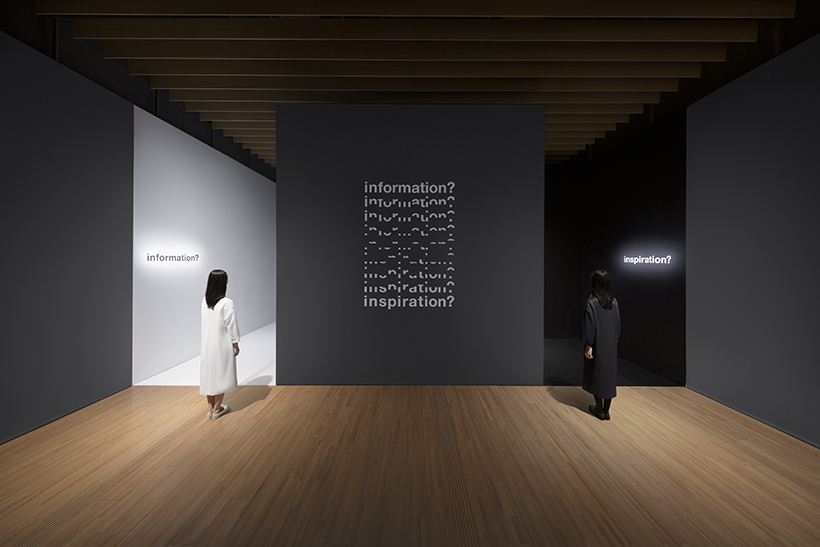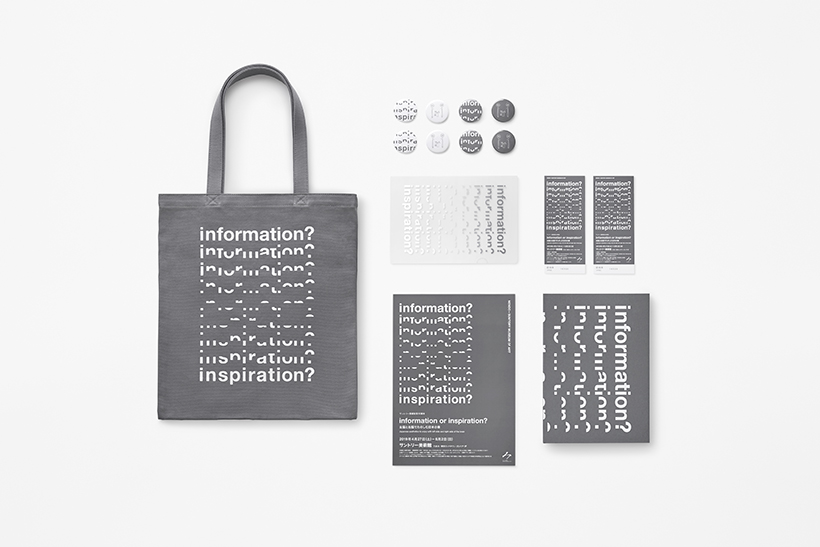Information or Inspiration?
Curatorship and design for a traditional Japanese art exhibition commissioned by the Suntory Museum of Art located in the Tokyo Midtown complex at Tokyo’s Roppongi district.
Born from the idea of the left and right sides of the brain, the exhibition introduces a new concept of display where visitors can choose between two different and distinctive routes; “information” or “inspiration”. The first route focuses on the informative and contextual aspects of the artworks in display. With the use of text and graphic data next to the objects, curious visitors can learn about the ideas behind the creative process and the artists’ intentions. The “inspiration” route suggests a more vague and minimal approach in which visitors can have a personal and maybe even emotional experience. In a darker dramatic setting, each object is presented in a way that captures its uniqueness. In this route the visitors can intuitively relate to the work without the use of words. Out of 3000 pieces from the permanent collection of the Suntory Museum of Art, 27 objects were carefully selected for the exhibition. The objects are placed in the centre of a custom-made display that is located right between the two routes, allowing each object to be viewed from both sides in two very different ways.
The “information” side, painted all white, shows the objects in a bright and traditional display, while the “inspiration” side, painted in black, showcases the objects in various ways, depending on the qualities of each individual object. After a comprehensive research process, it became possible to indicate the interesting and unique qualities of each object and accordingly design the specific display for each piece. For example, the traditional “Kiriko” glassware, unique for their delicate cutout patterns, are presented by showing the shadows of the objects, highlighting the textures rather than the objects themselves. The “Red Raku tea bowl, named Jukushi”, a unique Raku-ware tea bowl that has a base that is shaped like a persimmon, is presented with the use of a mirror that allows the visitors to notice only its special detail. The famous red Negoro lacquer technique is a layering method intended to gradually wear away with time and use, revealing the black lacquer under layer. The bottle that is painted with this technique in the exhibition is presented to the visitors behind a red filter. This effect eliminates the red tone of the lacquer and allows the object to appear in its slick black colour. The painting “Fragment of a Hyakunin Isshu (A hundred poets, ahundred poems)scroll on underpaintng of lotuses” is only a segment of an originally 25-meter long artwork created in the 17th century. The “inspiration” side reveals the unique process of creating this painting, displaying it as a part of an object made of several types of traditional Japanese paper. The painting “Poem from the Shin kokinshu (New poems ancient and modern) on underpainting of ivy” is presented in a decomposed layered array using transparent acrylic sheets in order to convey the multiple layers of drawing and calligraphy uniquely combined in this work. The “Smoking set with chrysthemum design in maki-e” is displayed with a modern ashtray, tobacco and lighter by its side, expressing to the viewers the contrast between our daily life in the past and in the present. Three glass-blown sake bottles that are slightly different than one another express the uniqueness of historical mass-production, where handmade objects were created without the use of molds. To best showcase this special quality in the “inspiration” side, a wall mounted installation was created, presenting identical replicas of the distorted bottles made ironically, with 3D printing technology, the ultimate single product production. A small space like “lid” welcome visitor to experience the surprise when opening the lid of “Hakudei Sometsuke Kinsai Susukimon Futamono.” The box “Covered box with silver grass design in underglaze blue, overglaze iron oxide, and gold” contains a surprising pattern when its lid is lifted. Therefore, in order to grant the visitors with the same excitement, they can enter a small space that replicates the same texture on its interior walls and ceiling, as if they were entering the box itself. In addition to the visual effects presented in the exhibition, other senses such as scent and touch were added to the experience; burning incense in proximity to a relevant object and manufacturing large-scale touchable reliefs for visitors to feel the textures they are viewing.
The exhibition spans across the fourth and third floors of the museum. Visitors can decide on their own journey through the space; they can start either from the “information” or the “inspiration” route, or can enjoy only one of them if they choose. The various ways to experience and walk through the exhibition will increase and encourage communication between visitors in the space. In the museum’s atrium in the middle of the space a new multimedia installation “uncovered skies” will be presented. The work features the four seasons, which are a significant part of Japanese culture and art. The installation also contains “inspiration” elements that can be experienced intuitively, and “information” elements that excite visitors to enjoy the production process and technical innovation.
The exhibition’s official book was designed to appear as if two separate books were combined to one; the “information” book contains text and data and the “inspiration” book consists of high-quality and detailed images. The concept behind the exhibition was not to determine the superiority between the two approaches. It was a conscious decision to separate the experience into two elements in order to refine their individual values. The recognition that there is an apparent “grey zone” lying between “information” and “inspiration” may be a paradoxical, hidden moral behind the exhibition.

